LONDON, 17th November 2010 – The results of a new research study conducted by Forrester Consulting on behalf of Cisco, investigating consumer viewing habits and expectations of TV and Internet-delivered TV has been released today. The study reveals that consumers are dictating where broadcasters, service providers and production companies invest their time and money when developing new technologies and services.
The study shows that continued consumer interest in next generation TV such as high definition TV (HDTV), 3DTV, on-demand and live streaming are pressuring major broadcasters and service providers to improve standards and offer a broader, more integrated service.
The study shows HDTV is fast becoming mainstream in the UK. However, the imminent arrival of 3DTV services will again raise consumers' expectations of quality, just as DVD did when it replaced VHS in the 1990s.
It's not just consumer's interests that are causing this sea change; it's their viewing habits too. Multiple generations of TV viewers are creating new markets and relationships for media companies. For example, simultaneous Internet use while watching TV is a common activity among young consumers now. Over 60 percent of those aged 16 to 35 watch TV and browse the Internet at the same time, and most likely to do so on a laptop or PC, as this age group is the least likely to own a TV set.
Key points:
Young Consumers leading development of 'Social TV'
'Social TV', the idea of discussing TV online while watching it, has much greater interest to young consumers aged under 25. Among 16 to 24 year olds, 47 percent like to chat online with friends while watching TV, compared with 20 percent or less of those in older age groups. Similarly, 28 percent of 16 to 24 year olds like to discuss the TV programme they are currently watching online with friends, compared with under 10 percent of all older groups.
This audience will be most likely to embrace simultaneous consumption of TV and Internet video. Coupled with the age group's device ownership, it's a fair indication that in the future a shift to Internet TV and interactivity will become more commonplace across all ages groups.
The Next Dimension
With 3D technology now common place in cinemas, at home with the launch of the first UK's first commercial 3DTV channel, and on pre-recorded Blu Ray discs, consumer appetite for such services is high. 43 percent of 16 to 24 year olds expressed interest in 3DTV and 33 percent of those aged 25 to 34. It would seem that the TV market is going through the largest transformation since the move from analogue TV to digital in the 1990s.
Laptop Generation
Alongside the ubiquitous home computer, new devices such as tablets and large screen smartphones are now enabling online TV consumption anywhere in the home. The freedom these wireless devices enable has significantly changed consumer TV viewing habits. 70 percent of online UK consumers now access the Internet in the living room, making it the most popular part of the home for web use.
Quality over Cost
While Internet Service Providers may choose to charge consumers a premium for faster speeds or a better quality of service at the same price, currently broadcasters don't. Interestingly, the study shows 22 percent of consumers say they would pay for better video picture quality, if they could guarantee it.
According to the Forrester and Cisco study, young consumers would not necessarily object to paying for premium picture quality and prefer to pay per item for media, rather than the traditional subscription payment model. This parallels the pre-pay model that has proved popular in the mobile industry and led to tremendous mobile adoption by teenagers.
Key facts/Highlights:
- UK consumer expectations of TV picture quality are being raised by High Definition TV. High levels of HDTV set adoption (now 57 percent of households) are being matched by rapid growth in HDTV subscriptions via satellite and cable. The arrival of 3DTV will continue this shift to higher quality: 43 percent of young consumers are interested in acquiring 3DTV service at home
- Consumers are experiencing picture quality issues with traditional TV. As TV has become digital and on-demand the increased flexibility has led to reliability problems. 31 percent of UK consumers experience stuttering or picture freezes and 17 percent sometimes need to switch their set off and on again to fix it
- When playback of online video stutters, consumers give up. 72 percent of online UK consumers reported issues with online video playback, with over 42 percent of those saying they then give up on viewing the content immediately. Interestingly, those watching short-form online video, such as clips on YouTube are more likely (52 percent) to give up than those watching longer-form content (42 percent) such as TV programmes and films. This shows the appeal of longer-form online video content and presents a positive outlook for the future of internet delivered TV services
- 22 percent of consumers will pay for a guaranteed improvement in video quality. This figure is significantly higher than the 11 percent of consumers that would pay for better broadband speeds. However, both figures are small compared with the level of online video consumption? Service providers and media organisations will begin to use multiple business models in order to monetise video and deliver acceptable picture quality to consumers
- Consumers hold ISPs and video publishers equally responsible for quality issues. Overall, 41 percent believe that the online video web site itself is responsible for ensuring good online video quality, while 43 percent believe that their ISP is responsible
- The arrival of new devices like tablets will further boost TV consumption. Mobile phones, home games consoles, and portable media players are all being used to watch online video. Alongside tablets these new devices will boost online video consumption. In particular they will boost simultaneous video consumption in the home, which will place increased pressure on service providers' networks
Supporting quote:
- Phil Smith, vice president and CEO, Cisco UK and Ireland:
"With video predicted to make up more than 91 percent of all internet traffic by 2014, it is clear that the growth of online video represents the next significant stage in the development of the Internet. This is part of a major shift in the way content is delivered and consumed but it also represents a challenge to Internet Service Providers and media companies. The fact that consumers hold ISPs and content providers equally responsible for any drop in video quality is a clear sign that these industries need to work together to ensure that are able to deliver a consistently high quality service to consumers."
Supporting Resources:
- Supporting video: Future of TV Cisco Forrester
Technorati Tags:
Cisco, Forrester Consulting, Project Canvas, HDTV, IPTV, social TV, internet video
RSS Feed for Cisco:
http://newsroom.cisco.com/dlls/rss.html
Methodology
In this study, Forrester conducted an online survey of 919 online consumers in the UK to investigate consumption of TV and Internet TV, together with their experiences and expectations of picture quality, and who they see as responsible for delivering quality.
Questions provided to the participants asked about their traditional and online video consumption, the digital devices they own and which ones they use to watch video, their willingness to pay for greater broadband speed, and their perceptions of service providers and media publishers.
Fieldwork for the study was conducted in February 2010, and the study was completed in June 2010.



